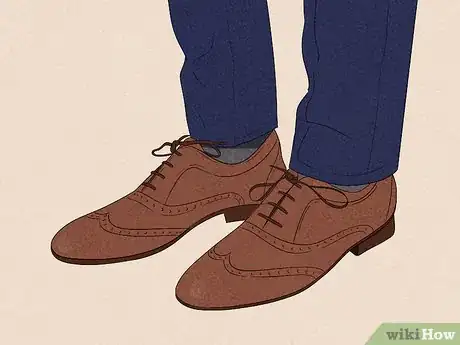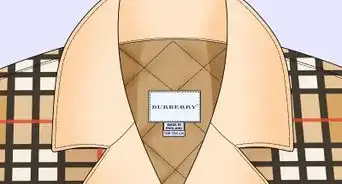This article was co-authored by Tannya Bernadette. Tannya Bernadette is the Founder of The Closet Edit, a Seattle-based personal styling service. She has been in the fashion industry for over 10 years and has been recognized as Ann Taylor’s LOFT brand ambassador and Seattle Southside’s official Rockstar Stylist. Tannya received her BA in Fashion Marketing and Business from The Art Institutes.
There are 11 references cited in this article, which can be found at the bottom of the page.
This article has been viewed 28,842 times.
Blue has become a very popular color choice for suits. There are many different shades of blue, making the color versatile throughout the year. You may be confused at first about what to pair with your suit, but dressing up is as simple as picking a shade of blue and selecting other clothing to match it. Pick darker colors for more formal settings and save lighter colors for informal ones. Include a tie, shoe, and accessories to complete your outfit. With proper coordination, you can wear a blue suit fashionably no matter where you’re going.
Steps
Creating a Formal Outfit
-
1Choose a midnight blue suit for special occasions. Midnight blue is a very dark color, so it’s best used in place of black. Wear your midnight blue suit for solemn events like weddings and funerals. It’s a little less formal but more versatile than black, meaning that it works well at any type of formal occasion. However, it’s too dark to be worn often outside of those events.[1]
- Midnight blue is what you want if you’re going for something slightly less serious than black. Black can feel too heavy and somber. Wear blue to bring a little bit of color to your outfit.
-
2Pick a white or gray shirt to match with a dark blue suit. White matches well and brightens up a dark suit. Gray is another option that can work, but go with a lighter shade to prevent the shirt from blending in too much with your suit. Choose a collared dress shirt that fits well underneath your suit jacket.[2]
- White shirts make color matching much easier. Gray requires a little bit more consideration when selecting your tie and accessories.
- White is great for formal settings. Gray is a little less formal, but it’s fine for all but the most somber events.
Advertisement -
3Put on a red or blue tie to contrast nicely with the white shirt. Select a deep, dark shade of red instead of a lighter one. Red also contrasts well with your suit, giving you some standout color without making your outfit look informal. If you’re looking for an alternative, choose a blue tie that is a similar shade to your suit. Since it won’t make you stand out as much, it’s perfect for serious occasions where you aren’t the center of attention.[3]
- If you’re feeling bold, try picking a lighter shade of blue. It will stand out much more, but you can match different shades of blue without much of a problem.
- Pick a tie with a heavy texture that looks distinct from the suit you’re wearing.
-
4Wear a pair of black or dark brown dress shoes to keep the look conservative. These shades work well for the most formal events imaginable. Save your black shoes for places with a strict dress code. If the rules aren’t quite as demanding, try using a dark shade of brown instead. Be sure to choose a pair of dress shoes with rounded tips instead of pointed ones.[4]
- Brown is far more versatile than black. If you have to choose one option, go with brown so you have shoes for a variety of settings.
-
5Limit your outfit to a few accessories if you need them. Formal outfits do not need a lot of dress up in the way of accessories. You can wear a nice gold watch and that would be enough to complete your look. Another option is to stuff a pocket square into your front pocket if your jacket has one.[5]
- Whatever you do, don’t wear a belt! It doesn’t look good as part of a formal outfit. Most belts also don’t match well with midnight blue.
- If you’re planning on including a pocket square, match it with the color of your shirt or tie. Red and white are usually great options.
Choosing a Semi-Formal Look
-
1Select a true blue suit to stand out more. True blue is a little lighter than navy blue, so it will draw more attention to your suit. It’s not good for formal events, but it can be worn during special occasions. Try wearing a true blue suit to a lighthearted party or business meetup, for instance. Don’t wear it too often, though.[6]
- If you’re looking for something more versatile, go with a navy blue suit instead. It’s better for frequent usage. Don’t wear a true blue suit more than once a week.
-
2Select a light blue or gray shirt for a nice contrast with your suit. White is always a good choice with true blue. However, since this type of suit is best for special occasions, consider wearing something lighter. Gray and light blue are both good choices. It will draw more attention to you and your suit, so make sure that is what you want when you settle on an outfit.[7]
- If you’re worried about finding matching shoes and a tie, stay with a white shirt.
- You could also try putting on a printed shirt. Keep the print light so it doesn’t stand out too much.
-
3Choose a patterned tie to stand out against a solid shirt. Look for something simple but distinct from your shirt and jacket. Try a light-colored tie, such as red or blue. Then, get one with a faint print, usually floral or stripes. Printed ties are more informal than solid ones and add some fun to your outfit.[8]
- If the event is more on the formal side of the spectrum, wear a solid tie instead. Choose a deep red color or a shade of blue that is a little lighter than your suit.
-
4Pick a shirt with a print if you want an eye-catching look. Stripes and floral patterns are a few examples of shirts you can wear underneath a blue suit. Prints look relatively informal, so reserve them for relatively informal events. You usually will not need to wear a tie or other accessories with the shirt.[9]
- Prints can contrast poorly with a suit, so choose them with caution. For example, don’t pair a print with a pinstripe suit.
- If you’re looking for a basic style that matches with most blue suits, choose a white shirt with a light print.
-
5Wear brown dress shoes that match the shade of your suit. For style, try wearing Derby shoes to formal events or loafers to more informal ones. The most important part is getting a medium shade of brown. Darker shades look too formal, but lighter shades look too casual. Strike a balance with a medium shade, such as burnished brown or mahogany.[10]
- Stay away from black or cream-colored shoes. They won’t look right when paired with your suit.
-
6Include few or no accessories with your outfit. A pocket square can work, but it may also look a little too formal. Usually, a nice watch and possibly a belt are more than enough. You don’t even need that much if you want your suit to do the talking.[11]
- Belts are always optional and many people think they should never be worn with a suit. If you choose to use one as an accessory, match it to the color of your shoes.
Dressing in Business Formal
-
1Pick navy blue for a suit that goes well with most colors. Navy blue is an everyday type of color. Although it is relatively dark, it is still light enough to make you stand out. It pairs well with both light and dark accessories, making it great for business events. You can mix and match your outfit each time you need to wear the suit.[12]
- If you have to choose one color, go with navy blue. It’s versatile enough to fit in at most formal and casual events. It’s also the best choice if you don’t wear suits very often.
- The downside of a navy blue suit’s versatility is that you have to select your outfit with care. Use darker colors for formality, but switch to lighter colors for casual settings.
-
2Wear a striped suit if you wish to look more informal. Every shade of blue has a pinstripe version. A pinstripe design consists of vertical stripes running down the entire suit. The stripes make the suit stand out more, so they are most common with darker shades of blue like navy. Choose a pinstripe design to add some flair to your outfit if you’re used to wearing plain suits all the time.[13]
- Pinstripes come in different sizes. Since big stripes stand out so much, stick to thinner stripes to prevent your suit from becoming too informal and distracting.
- Pinstripe designs often come in handy for day to day business settings. However, you will need to choose ties and other accessories carefully to avoid any color clashes with the stripes.
-
3Select a light, solid dress shirt that contrasts your suit. The standard color matches apply in a business setting. White is always a good choice, and gray also goes well with the darkness of a navy suit. Try a lighter shade of blue if you’re looking to add more color to your outfit.[14]
- Remember to coordinate your shirt choice with your tie. The shirt needs to be a different color than the tie.
-
4Pick a plain, solid tie that fits well in a business formal setting. Dark-colored ties are usually the best option for looking like a successful business person. Red or burgundy works well, but mix up your tie choices if you wear suits often. You could wear a black tie one day, then switch to a green one the next. Stay away from lighter colors that will make you stand out a little too much.[15]
- Pinstripes or other prints can work if you’re careful. Don’t wear these ties with a pinstriped shirt or jacket. Also, pick small, faint prints to keep your outfit spiffy.
-
5Select medium or dark-brown shoes to make your outfit office-ready. Since you’re targeting a relatively formal outfit, stick to standard Oxfords or another formal style. A business event isn’t the time to get experimental with your choice of footwear. Navy is deep but not as dark as some other suit options, so you don’t need to get the blackest shoes possible. Stick to colors like burnished brown or mahogany that match well with your suit jacket.[16]
- Test the shoes out before making them a part of your outfit. Look at yourself in the mirror to see how well they match with your jacket.
- Black shoes are too formal for business settings, so you’re better off sticking to brown.
-
6Include a watch or pocket square to spruce up your outfit. You don’t really need much in the way of accessories for business formal. If you want to look classy, tuck a colored pocket square into your front suit pocket. Slap a nice silver or gold watch onto your wrist. Don’t think too much about accessorizing, since too many of them will clash with your suit and shirt combination.[17]
- Never wear a belt to business formal. It looks too casual and you will probably be around people who don’t think it’s a good look.
Assembling a Casual Outfit
-
1Choose a light blue suit for casual and summer events. Very light shades of blue, including sky blue and baby blue, stand out a lot. These shades of blue should be saved for informal events where you don’t mind standing out. Lighter suits tend to pair well with darker accessories that provide some color contrast.[18]
- Light blue suits are associated with summer, so many of them are made with lightweight material like linen or seersucker.
-
2Select a basic white shirt if you’re planning on dressing brightly. Light blue suits can be very bright, so adopt white to balance out your outfit. White also pairs well with colorful ties, shoes, and accessories you may end up incorporating. It will contrast those items without any sort of contrast.[19]
- Although you can try wearing other colors, keep in mind that they may make your suit look a little too colorful. If you can, avoid wearing both a shirt and a tie that are a different color than your suit.
- White shirts are also good options if you like wearing your suit without a tie.
-
3Pick a pale shirt color if you want to add more color contrast. Stand out more by choosing a light blue, gray, lilac, or even pink dress shirt. These colors mix well even with darker shades of blue. They often look fashionable but not very formal, so pick colored shirts when you’re not dealing with a strict dress code.[20]
- Gray shirts are the most neutral of the options available and are better for formality without a lot of color clashing. Gray shirts don’t go well with bright ties or other accessories, so switch to white if you plan on using any.
- Light blue pairs well with darker blue suits. If you’re wearing a light blue suit, get lilac or pink for more contrast. Keep in mind that the shirt will stand out almost as much as the suit!
- Stay away from other colors, including green and yellow. They are too similar to blue and don’t pair well in large amounts.
-
4Wear a patterned shirt or tie if you want your outfit to be bold. Stripes and floral patterns are a few examples of what you could wear. Since you don’t need to worry as much about how informal these designs look, you can let them be a little louder than normal. Make sure they complement your suit well, particularly if you go with bigger prints or wilder colors. If you’re looking for something basic, stick with a light print on a standard color like white.[21]
- Prints are all about standing out. The shirt color should contrast your suit. For a tie, the color needs to contrast your shirt.
- If you’re not interested in the additional flair from patterned items, wear a simple white shirt.
-
5Go without a tie if you’re aiming for an informal look. You don’t always need a tie. Going without one can be a good strategy for the most casual events, such as hangouts with friends. Wear a nice shirt, then show it off by unbuttoning your jacket.[22]
- White shirts usually work best without a tie. They tend to appear neat and fashionable, but you could try another color for a bolder look.
-
6Get light-colored shoes if you’re creating a casual outfit. It’s difficult to pull off, but you can pair cream-colored shoes with a blue suit. If you’re planning on trying this, pick a light blue suit first. Complete the outfit by wearing a white shirt without a tie.[23]
- Remember that lighter colors tend to stand out more, so cream-colored shoes will make you much more visible. Save this kind of outfit for casual wear in summer.
- If cream isn’t your color, pick a lighter shade of brown. It doesn’t require as much work to fit into an outfit. Try a more casual style of shoe, such as brogues or monk straps.
-
7Match the belt to your shoes if you plan on wearing one. If you choose to wear a belt, get a shade of brown that matches your shoes. Don’t wear a belt with cream-colored shoes or sneakers. The belt will make your outfit look less formal, but that isn’t an issue when you know it is for a casual setting like a night out with friends.[24]
- Instead of wearing a belt, consider using suspenders instead. Suspenders hold up your pants like a belt but can be hidden underneath your jacket.
- To avoid your outfit from getting too cluttered, don’t wear any other accessories. You don’t need a tie or a heavy watch for a casual outfit.
Expert Q&A
-
QuestionCan you wear a print shirt with a suit?
 Tannya BernadetteTannya Bernadette is the Founder of The Closet Edit, a Seattle-based personal styling service. She has been in the fashion industry for over 10 years and has been recognized as Ann Taylor’s LOFT brand ambassador and Seattle Southside’s official Rockstar Stylist. Tannya received her BA in Fashion Marketing and Business from The Art Institutes.
Tannya BernadetteTannya Bernadette is the Founder of The Closet Edit, a Seattle-based personal styling service. She has been in the fashion industry for over 10 years and has been recognized as Ann Taylor’s LOFT brand ambassador and Seattle Southside’s official Rockstar Stylist. Tannya received her BA in Fashion Marketing and Business from The Art Institutes.
Professional Stylist Yes! A subtle print, like light blue and white or cream stripes, is appropriate for any occasion.
Yes! A subtle print, like light blue and white or cream stripes, is appropriate for any occasion.
References
- ↑ https://www.dmarge.com/2018/11/how-to-wear-blue-suit.html
- ↑ https://www.dmarge.com/2018/10/how-to-wear-light-blue-suit.html
- ↑ https://www.fashionbeans.com/article/mens-shirt-tie-combinations-guide/
- ↑ https://www.outfittrends.com/blue-suits-with-brown-shoes-men/
- ↑ https://www.dmarge.com/2018/11/how-to-wear-blue-suit.html
- ↑ https://www.youtube.com/watch?v=jDLibAs-How&feature=youtu.be&t=26
- ↑ https://www.dmarge.com/2018/11/how-to-wear-blue-suit.html
- ↑ https://www.youtube.com/watch?v=azNOFdc8RMM&feature=youtu.be&t=241
- ↑ https://www.youtube.com/watch?v=_NCcYGJbErM&feature=youtu.be&t=58
- ↑ https://www.outfittrends.com/blue-suits-with-brown-shoes-men/
- ↑ https://www.dmarge.com/2018/11/how-to-wear-blue-suit.html
- ↑ https://www.youtube.com/watch?v=_l8pA1DBh38&feature=youtu.be&t=77
- ↑ https://www.youtube.com/watch?v=R_9eeKb7AE4&feature=youtu.be&t=77
- ↑ https://www.fashionbeans.com/article/mens-shirt-tie-combinations-guide/
- ↑ https://www.fashionbeans.com/article/mens-shirt-tie-combinations-guide/
- ↑ https://www.outfittrends.com/blue-suits-with-brown-shoes-men/
- ↑ https://www.dmarge.com/2018/11/how-to-wear-blue-suit.html
- ↑ https://www.dmarge.com/2018/10/how-to-wear-light-blue-suit.html
- ↑ https://www.dmarge.com/2018/10/how-to-wear-light-blue-suit.html
- ↑ https://www.dmarge.com/2018/11/how-to-wear-blue-suit.html
- ↑ https://www.fashionbeans.com/article/mens-shirt-tie-combinations-guide/
- ↑ https://www.fashionbeans.com/article/wear-suit-without-tie/
- ↑ https://www.dmarge.com/2018/04/sneakers-suit.html
- ↑ https://www.dmarge.com/2018/10/how-to-wear-light-blue-suit.html


















































































